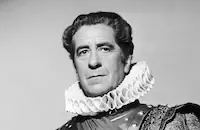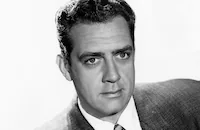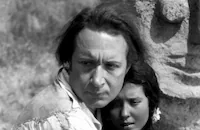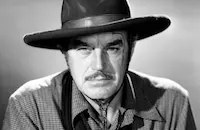Adventures of Don Juan

Brief Synopsis
Cast & Crew
Vincent Sherman
Errol Flynn
Viveca Lindfors
Robert Douglas
Alan Hale
Romney Brent
Film Details
Technical Specs

Synopsis
Near London, in the 17th century, notorious Lothario Don Juan barely escapes an angry husband, when he and his friend, Leporello, are stopped by a company of soldiers assigned to keep the road clear to accommodate a Spanish duke. Desperate to avoid the pursuing husband, Don Juan pretends to be the duke, only to discover that he is expected to marry Lady Diana. As Diana is beautiful, Don Juan decides to take advantage of the situation, but is thwarted by the arrival of the real duke. Don Juan and Leporello are subsequently arrested and ordered to be deported to Spain. Before Don Juan leaves England, Count De Polan, the Spanish ambassador, gives him a written introduction to Queen Margaret, the Spanish king's consort, and asks him to help prevent an impending war between Spain and England. Once in Spain, Don Juan and Leporello discover that, in their absence, their homeland has become a dispirited place. While they are resting at an inn, a press gang made up of the Duke de Lorca's soldiers arrives and harasses the residents. After Don Juan drives them away at sword point, he is accepted as a hero. The people speak favorably of Margaret, but are disappointed by her husband, King Phillip III, who is greatly influenced by the power-hungry Lorca. When Don Juan presents his letter to Margaret, she chastises him for his dalliance with Lady Diana, which disgraced the state and destroyed the possibility of a political marriage that would have helped prevent war between England and Spain. After Don Juan tells her about Lorca's press gang, she asks him to become a fencing instructor at the Royal Academy. Meanwhile, Lorca's men kidnap De Polan and demand the money he carries for Spain. When De Polan refuses, Lorca imprisons and tortures him. Lorca offers Don Juan a commission in the Spanish Navy and suggests that he increase the size of the academy with men who would then be drafted into the Navy. Don Juan greatly angers Lorca when he turns down the commission, stating that Lorca is apparently preparing for a war that would be disastrous for Spain. Don Juan then reports to Margaret and tells her that he has fallen in love with her. Margaret angrily rejects him, and Don Juan returns to his promiscuous ways. The ensuing scandal enables the king and Lorca to order his exile to the New World. Don Juan escapes, but while making preparations for his departure, he notices a soldier wearing a ring that belongs to De Polan. Learning of De Polan's capture, Don Juan rides to the court to tell Margaret and the king what he knows. Against the wishes of the king, Lorca orders Don Juan's arrest, and he is taken to the fortress to be executed. Leporello and the fencing master help Don Juan escape and together they rescue De Polan. With the help of his fencing students, Don Juan overcomes Lorca and his men. Later, Margaret admits that she returns Don Juan's love, but he replies that he would never jeopardize the future of Spain by taking her away from her position. Instead, he announces that he will leave Spain because he can never have the woman he truly loves. Despite his broken heart, however, Don Juan does not give up his search for beauty and is soon pursuing another lovely young woman.

Director

Vincent Sherman
Cast

Errol Flynn

Viveca Lindfors

Robert Douglas

Alan Hale
Romney Brent

Ann Rutherford

Robert Warwick
Jerry Austin

Douglas Kennedy
Jeanne Shepherd
Mary Stuart

Helen Westcott

Fortunio Bonanova
Aubrey Mather

Una O'connor

Raymond Burr
Tim Huntley
David Leonard
Leon Belasco
James Craven

Penny Edwards
Joan Winfield
Dick Walsh
Jean Stewart
Sanders Clark

Barbara Bates
Harry Lewis
Kate Lawson
Mickey Simpson
Frances Rey

Karen Randle
Linda Lombard
Lonnie Baiano
Karen Knight
Caren Marsh
Pedro De Cordoba
John Arnold
David Bruce
Gordon Clark
David Cota

Monte Blue

Harry Woods
Harry Hayes Morgan
Tony Romano
Crew
J. Leslie Asher
Curtis Baessler
Cherie Banks
Marjorie Best
Elwood Bredell
Everett A. Brown
Edward Carrere
Albert Cavens
Fred Cavens
Alan Crosland Jr.
John Crouse
Murray Cutter
Herbert Dalmas
Roy Dumont
Frank Flanagan
Morris Goldman
Helen Goodman
Sol Gorss
Al Greene
Herbert S Greene
Fay Hamilton
Ward Hamilton
Rudy Harrington
Natalie Kalmus
Mitchell Kovaleski
Harry Kurnitz
Lloyd Maclean
Frank Mattison
Richard Mayberry
William Mcgann
Maurice Murphy
Harold Noyes
Joe O'connell
George Oppenheimer
John Pofahl
Norman Pringle
Lyle B. Reifsnider
Leah Rhodes
Mike Ryan
Max Steiner
Wandra Sybald
Travilla
Don Turner
Jerry Wald
Perc Westmore

Photo Collections
Videos
Movie Clip



Trailer
Hosted Intro
Film Details
Technical Specs

Award Wins
Best Costume Design
Award Nominations
Best Art Direction
Articles
The Adventures of Don Juan
Final line from The Adventures of Don Juan (1948)
Warner Bros. wanted to cash in on Errol Flynn's image as Hollywood's greatest Don Juan with this 1948 action adventure. It took them four years and more than $2 million to get the picture to the screen, and by that time it's star was beginning to feel that his Don Juan days were over.
The studio first started developing The Adventures of Don Juan in 1945, but between problems in getting the right script and an art director's strike, it was four years before they could start work. Originally, Raoul Walsh, who'd scored hits with Flynn on such pictures as They Died With Their Boots On (1941) and Gentleman Jim (1942), was supposed to direct. By the time the script was ready, however, Flynn was on the outs with Walsh. Ann Sheridan had had a good time working with director Victor Sherman on Nora Prentiss (1947) and The Unfaithful (1947), so Flynn requested Sherman on her advice.
Flynn started the film on his best behavior. Though he had a reputation for showing up on set hung over and getting drunk after lunch, he promised Sherman to behave himself. But the 38-year-old Flynn was beginning to feel the effects of what he would call in his memoirs My Wicked, Wicked Ways. Production was delayed by various illnesses, and he needed extensive doubling for the film's many action scenes. During the climactic duel with villain Robert Douglas, Sherman couldn't find anybody to do Don Juan's leap down a massive staircase until future Tarzan Jock Mahoney stepped in.
To make things worse, Flynn was tiring of his image. For all his success, he would later write, "I found that at the top of the world there was nothing. I was sitting on the pinnacle, with no mountain under me." His one hope was to gain recognition as an actor as well as an action star. During the first days of shooting, he seemed dedicated to just that. When the script wasn't quite right, Flynn even improvised brilliantly. Then he got bad reviews for a rare dramatic role in Escape Me Never (1947). The next day, Flynn started drinking on the set.
For all Flynn's problems, however, Sherman and producer Jerry Wald managed to turn in a sumptuous, fast moving picture. Despite solid reviews, however, the film did poorly at U.S. box offices, prompting Warners to cut the budgets on future Flynn vehicles. But if this was the beginning of the end for Flynn, at least he went out with a bang. As Newsweek's critic wrote, ". . . there are enough swordplay and bouncing bravura in The Adventures of Don Juan to activate two films of this sort . . ."
Director: Vincent Sherman
Producer: Jerry Wald
Screenplay: Herbert Dalmas (story), George Oppenheimer, Harry Kurnitz, William Faulkner (uncredited)
Cinematography: Elwood Bredell
Editor: Alan Crosland Jr.
Art Direction: Edward Carrere
Music: Max Steiner
Cast: Errol Flynn (Don Juan), Viveca Lindfors (Queen Margaret), Robert Douglas (Duke de Lorca), Alan Hale (Leporello), Romney Brent (King Phillip III).
C-111m. Close captioning. Descriptive Video.
by Frank Miller

The Adventures of Don Juan
Quotes
My dear friend, there's a little bit of Don Juan in every man, and since I am Don Juan, there must be more of it in me!- Don Juan
The sword is not for a traitor. You'll die by the knife!- Don Juan
Catherine, an artist may paint a thousand canvases before achieving one work of art. Would you deny a lover the same practice?- Don Juan
Beloved, no power on Earth could've kept me from you. In all the world there's been but one image in my heart, one vision before my eyes...- Don Juan
Yes, yes, go on...- Catherine
I have loved you since the beginning of time.- Don Juan
But you only met me yesterday...- Catherine
Why, that was when time began!- Don Juan
But how long will you love me?- Catherine
Sweet lady, love is not measured in terms of time, only in ecstasy!- Don Juan
Trivia
Claude Rains was originally cast as the Duke de Lorca.
At the end of the film, the young woman in the coach asking Don Juan for directions is Errol Flynn's second wife, Nora Eddington.
The last of 13 films that Alan Hale appeared in with close friend 'Errol Flynn' . Hale died on 22 January 1950, just over a year following its release.
Notes
Scholars believe that Don Juan's real name was Migul de Manara. According to an April 18, 1944 Los Angeles Examiner news item, writer John Taintor Foote had prepared a screenplay for the studio. His contribution to the final script is undetermined. Adventures of Don Juan was slated for production in 1945, according to Warner Bros. interoffice memos reproduced in a modern source. The memos add that Raoul Walsh and Jean Negulesco were at different times assigned to direct the film, which was postponed for various reasons, including a lengthy industry strike. Negulesco was dropped when Vincent Sherman was assigned at Errol Flynn's request, according to Warner Bros. memos. A December 26, 1947 Hollywood Reporter news item notes that more than 5,200 costumes were made for the film, including fifteen for Viveca Lindfors, eighteen for Robert Douglas, twelve for Romney Brent and eleven for Alan Hale. Their efforts earned Leah Rhodes, Travilla and Marjorie Best an Oscar for Best Costume Design. The film was also nominated for Best Art Direction-Set Decoration in a color picture. One hundred and thirteen sets were constructed, according to a January 2, 1948 Hollywood Reporter news item. Production shut down between 14 January and January 28, 1948 when Errol Flynn developed influenza. According to studio memos reprinted in a modern source, the film used some stock shots from The Adventures of Robin Hood and The Private Lives of Elizabeth and Essex (see AFI Catalog of Feature Films, 1931-40; F3.0021, F3.3546). A modern source notes that William Faulkner worked on the screenplay. Among the many films made about Don Juan are the 1906 French film Don Juan; the 1926 Warner Bros. film Don Juan, starring John Barrymore and Mary Astor and directed by Alan Crosland (see AFI Catalog of Feature Films, 1921-30; F2.1392); and The Private Life of Don Juan, released by United Artists in 1934, which starred Douglas Fairbanks and Merle Oberon (see AFI Catalog of Feature Films, 1931-40; F3.5439).
















